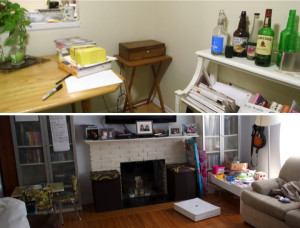Designing digital products, services and systems that envision support of our everyday practices over long periods of time (5 to 50 years) is a critical concern for designers of interactive technology. Many visions and implementations of ‘smart’ technologies for the home exist, yet little research has investigated the design integration of form, material, and computation in artifacts to achieve viable and valuable long-term relationships with our domestic and everyday lives. Unaware objects aim to manifest a new type of smart product that supports cumulative intersections over direct interaction and the ability to become part of ensembles in our daily settings rather than separate from our everyday contexts. This project draws on two Research through Design works, the Photobox and table-non-table, to theoretically and empirically develop a series of related concepts to support radically new ways of creating technologies that could find a longer-term place in the home.

The Photobox (top) and table-non-table (bottom) living in households during field deployments.
The Photobox is a networked oak chest that will occasionally randomly select and print a photo from its owner’s online Flickr archive. Its owner has no control over what will print or when. The table-non-table is a slowly moving stack of paper supported by a motorized aluminum chassis. The chassis and motors are strong enough to support stacking of heavy objects or a person sitting or standing on it. It moves in short bursts (5-12 seconds) occurring once during a reasonably long period of time (50-120 minutes). Collectively, the Photobox and table-non-table are interaction design artifacts that are designed to exist without demanding the attention of their owner. They are unaware objects that lack any kind of traditional interface and execute preset computational processes. This work illustrated how unawareness can be a rich and effective design strategy for providing sustained experiences of anticipation, enjoyment, and resourcefulness over time.
Publication
William Odom and Ron Wakkary. 2015. Intersecting with Unaware Objects. In Proceedings of the 2015 ACM SIGCHI Conference on Creativity and Cognition (C&C ’15). ACM, New York, NY, USA, 33-42. (Local Copy, ACM Link)
Related Works
Odom, W., Sellen, A., Kirk, D., Banks, R., Regan, T., Selby, M., Forlizzi, J., Zimmerman, J. (2014). Designing for Slowness, Anticipation and Re-Visitation: A Long Term Field Study of the Photobox. In proceedings of SIGCHI Conference on Human Factors in Computing Systems. Toronto, Canada. CHI ’14. ACM Press. *Best Paper Award* (Local Copy, ACM Link)
Odom, W., Selby, M., Sellen, A., Kirk, D., Banks, R., Regan, T. (2012). Photobox: On the Design of a Slow Technology. In Proceedings of Designing Interactive Systems, Newcastle, UK. DIS ’12. ACM Press. (Local Copy, ACM Link)
Odom, W., Wakkary, R., Lim, Y., Desjardins, A., Banks, R., Hengeveld, B. (2016, in press). From Research Prototype to Research Product. In Proceedings of SIGCHI Conference on Human Factors in Computing Systems. San Jose, USA. CHI ’16. ACM Press.
Wakkary, R., Odom, W., Hauser, S., Hertz, G., Lin, H. (2015). Material Speculation: Actual Artifacts for Critical Inquiry. In Proceedings of the 5th decennial conference on Critical computing: Critical Alternatives. (CC ’15). ACM Press.